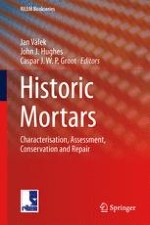2012 | OriginalPaper | Buchkapitel
The Hydration of Modern Roman Cements Used for Current Architectural Conservation
verfasst von : Christophe Gosselin, Karen L. Scrivener, Steven B. Feldman, Wolfgang Schwarz
Erschienen in: Historic Mortars
Verlag: Springer Netherlands
Aktivieren Sie unsere intelligente Suche, um passende Fachinhalte oder Patente zu finden.
Wählen Sie Textabschnitte aus um mit Künstlicher Intelligenz passenden Patente zu finden. powered by
Markieren Sie Textabschnitte, um KI-gestützt weitere passende Inhalte zu finden. powered by
